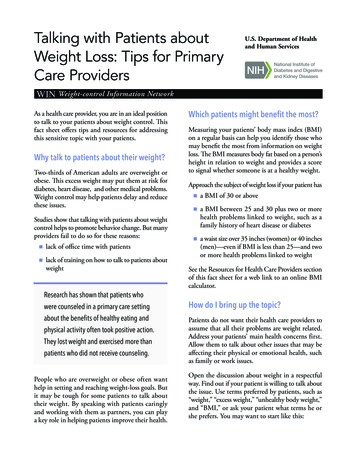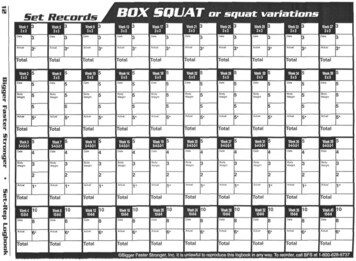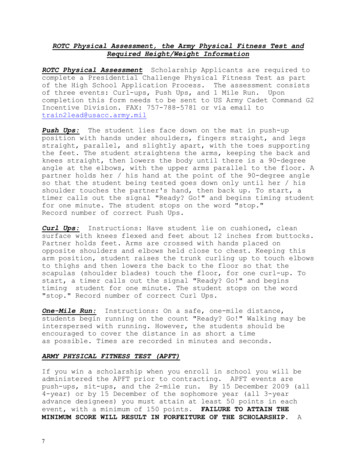
Transcription
Talking with Patients aboutWeight Loss: Tips for PrimaryCare ProvidersU.S. Department of Healthand Human ServicesWIN Weight-control Information NetworkAs a health care provider, you are in an ideal positionto talk to your patients about weight control. Thisfact sheet offers tips and resources for addressingthis sensitive topic with your patients.Why talk to patients about their weight?Two-thirds of American adults are overweight orobese. This excess weight may put them at risk fordiabetes, heart disease, and other medical problems.Weight control may help patients delay and reducethese issues.Studies show that talking with patients about weightcontrol helps to promote behavior change. But manyproviders fail to do so for these reasons: lack of office time with patients lack of training on how to talk to patients aboutweightResearch has shown that patients whoWhich patients might benefit the most?Measuring your patients’ body mass index (BMI)on a regular basis can help you identify those whomay benefit the most from information on weightloss. The BMI measures body fat based on a person’sheight in relation to weight and provides a scoreto signal whether someone is at a healthy weight.Approach the subject of weight loss if your patient has a BMI of 30 or above a BMI between 25 and 30 plus two or morehealth problems linked to weight, such as afamily history of heart disease or diabetes a waist size over 35 inches (women) or 40 inches(men)—even if BMI is less than 25—and twoor more health problems linked to weightSee the Resources for Health Care Providers sectionof this fact sheet for a web link to an online BMIcalculator.were counseled in a primary care settingHow do I bring up the topic?about the benefits of healthy eating andPatients do not want their health care providers toassume that all their problems are weight related.Address your patients’ main health concerns first.Allow them to talk about other issues that may beaffecting their physical or emotional health, suchas family or work issues.physical activity often took positive action.They lost weight and exercised more thanpatients who did not receive counseling.People who are overweight or obese often wanthelp in setting and reaching weight-loss goals. Butit may be tough for some patients to talk abouttheir weight. By speaking with patients caringlyand working with them as partners, you can playa key role in helping patients improve their health.Open the discussion about weight in a respectfulway. Find out if your patient is willing to talk aboutthe issue. Use terms preferred by patients, such as“weight,” “excess weight,” “unhealthy body weight,”and “BMI,” or ask your patient what terms he orshe prefers. You may want to start like this:
“Ms. Brown, your BMI is above the healthy range.Excess weight could increase your risk for somehealth problems. Would you mind if we talkedabout it?”Be alert to cultural differences that your patients maybring to the table about weight, favorite foods, socialnorms and practices, and related issues. Patientsmay be more open when they feel respected. SeeResources for Health Care Providers for a link tothe Weight-control Information Network (WIN)fact sheet Medical Care for Patients with Obesity,which offers tips for respectful treatment of obesepatients in medical settings.See the tear-off sheet at the end of this fact sheet fortips and resources to share with patients.How can I help my patients set goals?What do patients want to know?Ask your patients how ready they are to adopthealthier eating and physical activity habits. Workas a partner with each patient to develop a plan.Some questions to ask are these:Patients often want information on safe and effectiveways to control their weight. A patient who is notyet ready to attempt weight control may still benefitfrom talking about healthy eating and regularphysical activity.“What are your goals regarding your weight?”Ask patients about their eating habits. Encouragethem to replace foods high in fat, refined grains,and/or sugar with healthier options. Make themaware of the healthy eating resources available fromthe U.S. Department of Agriculture. For example,“What kind of changes would you be willing tostart with?”“What kinds of foods do you eat on a typical day?”Partner with your patients to identify concreteactions they can take to meet their weight goal overthe next 6 months.“What kind of help would you like from meabout your weight?”“What does ‘healthy eating’ mean to you?”Find out if your patients are meeting the Governmentrecommendations for physical activity. Make themaware that being inactive, especially sitting for longperiods of time at work or at home, may not be goodfor their health. You may want to ask,What is a sensible weight-loss goal?“How much time do you spend sitting downeach day?”“Do you know how much physical activity youshould do each week to stay healthy?”2 Losing weight too quickly may contributeto health problems, such as gallstones. A 5-to-7 percent reduction in body weightover 6 months is a sensible weight-loss goal. One-half to 2 pounds per week is a saferate of weight loss.
How can I help my patients stick withtheir goals?Some patients may benefit from information onbariatric surgery as a treatment for obesity. You mayfind WIN’s fact sheet Bariatric Surgery for SevereObesity helpful to give to patients (see Resourcesfor Health Care Providers). Be prepared to make areferral to a specialist who can work with the patientto find out if weight-loss surgery is a good optionfor him or her.Praise can help inspire your patients to maintainnew behaviors. When you see patients again, notetheir progress. Offer praise to boost self-esteem andkeep them motivated.Some patients may lose weight very slowly, which canbe discouraging. Note any advances in related riskfactors, like blood pressure, blood sugar, and highcholesterol. Improving the health numbers relatedto these factors may motivate patients, especially ifchanges are made despite slow weight loss.What type of patients may be bestsuited for bariatric surgery?Bariatric surgery may be the next step forpatients who remain severely obese aftertrying approaches other than surgery‚especially if they have a disease linked toobesity.Discuss any setbacks, and help your patients toovercome challenges. Work with your patients toset new goals. Discuss eating and physical activityhabits to change or maintain.Among adults, bariatric surgery may be anoption if the patient has A BMI 40 or A BMI 35, along with a serious healthproblem linked to obesity, such as type 2diabetes, heart disease, or severe sleep apneaResearchThe National Institute of Diabetes and Digestive andKidney Diseases (NIDDK) conducts and supportsa broad range of basic and clinical obesity research.More information about obesity research is availableat http://www.obesityresearch.nih.gov.Clinical trials are research studies involving people.Clinical trials look at safe and effective new ways toprevent, detect, or treat disease. Researchers also useclinical trials to look at other aspects of care, such asimproving the quality of life for people with chronicillnesses. To learn more about clinical trials, why theymatter, and how to participate, visit the NIH ClinicalResearch Trials and You website at http://www.nih.gov/health/clinicaltrials. For information about currentstudies, visit http://www.ClinicalTrials.gov.What if a patient needs more help?In some cases, you may prefer to refer your patient toa weight-loss program or a registered dietitian whofocuses on weight control. The Academy of Nutritionand Dietetics offers referrals to registered dietitiansthroughout the United States. See the Resources forPatients section for contact information.3
Weight-controlInformation NetworkResources for Health Care ProvidersAdditional Reading from the Weight-control Information NetworkYou can access the brochures and fact sheets listed below online athttp://www.win.niddk.nih.gov/publications. You may also request copies by callingWIN toll-free at 1–877–946–4627. Bariatric Surgery for Severe Obesity explains how this operation on thestomach and/or intestines helps patients with extreme obesity to loseweight. Patients may use this fact sheet to talk about this option with theirhealth care providers. This fact sheet explains which patients might choosethis option and describes the different types of bariatric surgery (availableonline at htm).Medical Care for Patients with Obesity helps health care providers addressthe concerns of patients with obesity and create offices that welcome allpatients (available online at htm).Other Resources on Weight Control 3 Steps to Initiate Discussion About Weight Management With YourPatients, from the National Heart, Lung, and Blood Institute (NHLBI),offers tips to health care providers about initiating respectful dialogue withpatients about weight management. Available at /aim kit/steps.pdf. Aim for a Healthy Weight Provider Kit is a patient education kit fromthe NHLBI that helps health care providers develop effective programs forweight management in their offices or clinics. The kit is available tional/lose wt/. BMI Calculator is a free tool from the NHLBI for the iPhone, Palm OS, andPocketPC. This tool is available at ty/lose wt/bmitools.htm. Screening for and Management of Obesity in Adults: U.S. PreventiveServices Task Force Recommendation Statement provides informationon the Task Force recommendation that clinicians screen adults for obesityand provide appropriate referrals. Annals of Internal Medicine. 2012. Thearticle is available at http://annals.org/.Inclusion of resources is for information only and does not imply endorsementby NIDDK or WIN.Photo on page 2 courtesy of Alex E. Proimos.http://www.flickr.com/photos/proimos/1 WIN WayBethesda, MD 20892–3665Phone: 202–828–1025Toll-free number: 1–877–946–4627Fax: 202–828–1028Email: The Weight-control InformationNetwork (WIN) is a nationalinformation service of the NationalInstitute of Diabetes and Digestiveand Kidney Diseases (NIDDK), partof the National Institutes of Health(NIH). WIN provides the generalpublic, health professionals, and themedia with science-based, up-to-date,culturally relevant materials and tips.Topics include how to consume healthyfoods and beverages, barriers to physicalactivity, portion control, and eating andphysical activity myths.Publications produced by WIN arereviewed by both NIDDK scientists andoutside experts. This publication was alsoreviewed by Rebecca Puhl, Ph.D., of theRudd Center for Food Policy & Obesityat Yale University.This publication is not copyrighted.WIN encourages you to duplicate anddistribute as many copies as desired.This publication is also available athttp://www.win.niddk.nih.gov.You may also find additional informationabout this topic by visiting MedlinePlus athttp://www.medlineplus.gov.NIH Publication No. 05–5634November 2005Updated November 2012NIH Turning Discovery Into Health 4
Healthy Eating and Physical ActivityTips to Share with Your PatientsShare these ideas with your patients to support their efforts to lose weight or keep a healthy weight.Resources for patients are listed on the back of this sheet.Set goals for weight controlBe more activeEncourage your patients toEncourage your patients to Identify specific goals for losing excess weightor maintaining a healthy weight. Check out the Government’s physical activityguidelines (see the back of this sheet). List concrete actions they will take to increasehealthy eating and physical activity. Set sensible weight loss goals, such as losing 5 to7 percent of their body weight over 6 months.Do 150 minutes a week of moderately intenseaerobic activity (about 30 minutes on mostdays). Tell them that aerobic activity uses theirlarge muscle groups (back, chest, and legs) toincrease their heart rate and breathing. Choose aerobic activities that are fun, like briskwalking, dancing, playing a sport, or swimming. Build strength with weight lifting or otherweight-bearing exercises at least 2 days per week.If they don’t have weights, they can use booksor cans of food to do arm curls. Get up and get moving. Sitting for long periodsof time may lead to weight gain. They can gofor a walk or take the stairs, making sure thestairs are well lit.Create a healthy eating planEncourage your patients to Check out the Government’s tip sheets onhealthy eating at the MyPlate website (see theback of this sheet). Eat more of these foods: beans, fat-free or lowfat cheese and milk, fruits and vegetables, leanmeats and seafood, nuts, whole grains (brownrice and oatmeal). Limit these foods: breads and pasta made withrefined grains, foods with butter or other fatsthat are solid at room temperature, and sugarsweetened drinks and desserts.
Resources for PatientsReading from the Weight-controlInformation Network (WIN)You can access brochures and fact sheets listed below onlineat http://www.win.niddk.nih.gov/publications. You may alsorequest copies by calling WIN toll-free at 1–877–946–4627. Active at Any Size explainsthe benefits of regular physicalactivity. This brochure alsodescribes activities that peoplewho are overweight or obesecan enjoy safely.Changing Your Habits: Stepsto Better Health explains howpeople can take small steps tobecome more physically activeand consume healthier foodsand beverages.Getting on Track: PhysicalActivity and Healthy Eatingfor Men is a brochure thatoffers tips to help men bephysically active and consumehealthy foods and beverages.The World Around Youprovides tips on how to use theworld around you, no matterwho you are or where you live,to stay healthy and fit.Other Resources 2008 Physical Activity Guidelines for AmericansU.S. Department of Health and Human Services (HHS)http://www.health.gov/paguidelines Academy of Nutrition and Dieteticshttp://www.eatright.org Aim for a Healthy WeightNational Heart, Lung, and Blood art/obesity/lose wt Dietary Guidelines for Americans, 2010HHS and the U.S. Department of Agriculture (USDA)http://www.health.gov/dietaryguidelines Food and Nutrition Information CenterUSDAhttp://www.nal.usda.gov/fnic MyPlateHHS and USDAhttp://www.choosemyplate.gov National Diabetes Education Programhttp://yourdiabetesinfo.org U.S. Government Website on NutritionUSDAhttp://www.nutrition.govInclusion of resources is for information only and does notimply endorsement by NIDDK or WIN.
actions they can take to meet their weight goal over the next 6 months. What is a sensible weight-loss goal? Losing weight too quickly may contribute to health problems, such as gallstones. A 5-to-7 percent reduction in body weight over 6 months is a sensible weight-loss goal. One-half to 2 pounds per week is a safe rate of weight loss.










